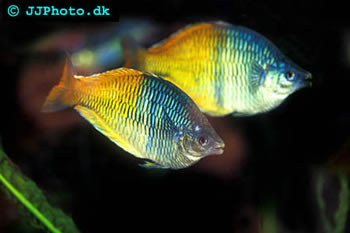Boeseman's Rainbowfish - Melanotaenia boesemani
The Boeseman's Rainbowfish was scientifically described by Allen & Cross in 1980. Its scientific name is Melanotaenia boesemani.
Description
Boeseman's Rainbowfish can exceed 11 cm (4.3 inches) in length. The rear half of the body is of a vivid orange colour, while the head and anterior body part are blue-grey. The body is also decorated with narrow dark bars. The fins are orange and the two dorsal fins have a white outer margin.
The males have more vivid colours than the females, especially on the rear half of the body.
Geographical distribution, habitat and conservation
Boeseman's Rainbowfish lives in the western part of Western New Guinea (former Irian Jaya). The species has only been encountered in the Ayamaru Lakes region, which is located in the centre of the Vogelkop Peninsula. This region is where you will find the headwaters of the Ayamaru River. Boeseman's Rainbowfish is not only present in Lake Ayamaru, it has also been found in Lake Hain and Lake Aitinjo, as well as in streams flowing into Lake Ayamaru. Lake Ayamaru is situated roughly 55 meters (180 feet) above sea level and surrounded by a hilly environment. Both Lake Hain and Lake Aitinjo are situated within 20 km (12.5 miles) of Lake Ayamaru.
The typical Boeseman's Rainbowfish habitat is shallow and swampy with clear water and lush aquatic vegetation. Lake Ayamaru as well as the nearby streams are really alkaline with a pH-value over 8.0.
Boeseman's Rainbowfish is threatened by over-harvesting since it has become such a popular aquarium fish. By the end of the 1980’s, roughly 60 000 male specimens where exported from the Ayamaru Lakes region each month. Today, the government has restricted the trade in an effort to prevent over-harvesting and decrease the mortality rate. Boeseman's Rainbowfish is listed as “Endangered” in the IUCN Red List of Threatened Species.
Keeping Boeseman's Rainbowfish in aquariums
|
You can either keep Boeseman's Rainbowfish in a species aquarium or combine it with peaceful species of a similar size in a community set up. Try to resemble the natural habitat for the Boeseman's Rainbowfish in the aquarium and include a lot of lush plants. The recommended water temperature is 25-30 degrees C (77-86 degrees F). The water should be alkaline, from pH 7.2 to 8.0. In the natural environment of Boeseman's Rainbowfish, it is normal for the pH-value to exceed 8.0.
Young Boeseman's Rainbowfish specimens tend to be more sensitive to chlorine than mature fish. Let the chlorine evaporate from the water before you use it for water changes if you use chlorinated tap water.
Keep your fish on a varied diet that contains live food. You can for instance combine high-quality flakes with live foods such as brine shrimp and insect larvae. Boeseman's Rainbowfish might very well survive on dry food only, but it will not thrive and it can loose its vibrant colours.
Breeding Boeseman's Rainbowfish
If you want to try breeding rainbowfish, Boeseman's Rainbowfish is a suitable first choice because this fish will readily spawn in the aquarium and the offspring is not very hard to raise. They are normally bred in groups consisting of at least 2-3 females for each male. A 50-75 L (13-20 gallons) aquarium is large enough to serve as breeding aquarium for a small group with only one male fish. The breeding aquarium should be well planted and contain suitable spawning media, e.g. densely grow java moss and/or spawning mops. Feed the fish ample amounts of live meaty foods.
The males can be really aggressive towards the females during the breeding period; that is why a well planted aquarium and a suitable sex-ratio are important. During the courting period, the male fish will display a frosty white colouration on top of his head. One the spawning has commenced, the female fish can release up to 20 eggs each day. Boeseman's Rainbowfish will normally not eat their own offspring, especially not when well fed and kept in a planted aquarium where the fry can hide. It is therefore not necessary to move the eggs to a separate rearing container, unless you have particularly voracious fish in your breeding aquarium.
If you keep the water temperature in the lower end of the recommended range, the eggs will normally need about two weeks of incubation. A higher water temperature can speed up the process. You can feed the fry infusoria, egg yolk and finely grounded flake food until they are big enough to eat newly hatched brine shrimp and nibble at whole flakes.
Didn't find the info you were looking for? Register for free and ask your question in our Aquarium forum !
Our knowledgeable staff usually responds to any question within 24 hours
Other New Guinea Rainbowfishes
Axelrods Rainbowfish
Bleher’s Rainbowfish
Bulolo Rainbowfish
Higlands Rainbowfish
Silver Rainbowfish
Barred Rainbowfish
Lorentz’s Rainbowfish
Sentani Rainbowfish
Red Rainbowfish
Spotted Rainbowfish
Sepik Rainbowfish
Tami River Rainbowfish
Ramu Rainbowfish
Lake Wanam Rainbowfish
Threadfin Rainbowfish
Northern Rainbowfish
Ayamaru Rainbowfish
Angfa Rainbowfish
Arfak Rainbowfish
Corona Rainbowfish
Waigeo Rainbowfish
Serong Rainbowfish
Goldie River Rainbowfish
Lake Tebera Rainbowfish
Irian Jaya Rainbowfish
Strickland Rainbowfish
Yapen Rainbowfish
Lake Kutubu Rainbowfish
McCulloch’s Rainbowfish
Mayland’s Rainbowfish
Misool Rainbowfish
Mountain Rainbowfish
Ogilby’s Rainbowfish
Oktedi Rainbowfish
Parkinson’s Rainbowfish
Lake Kurumoi Rainbowfish
Pima River Rainbowfish
Dwarf Neon Rainbowfish
Fly River Rainbowfish
Red Striped Rainbowfish
Van Heurn’s Rainbowfish

